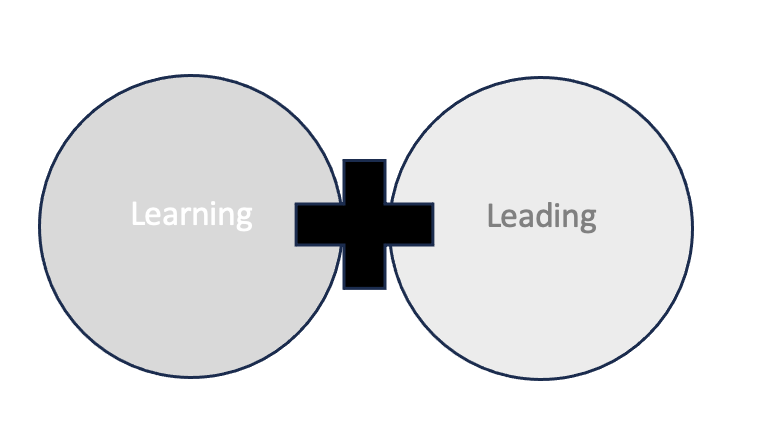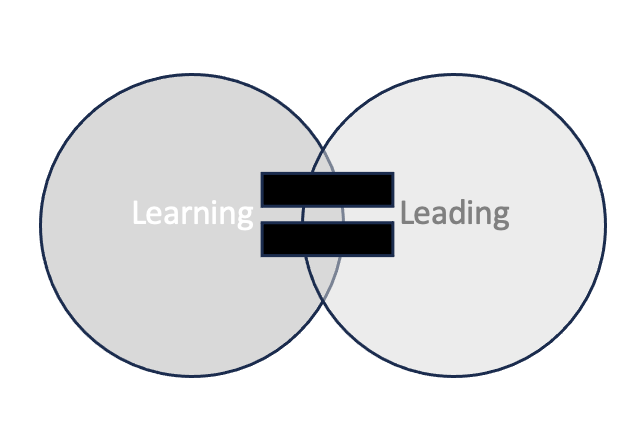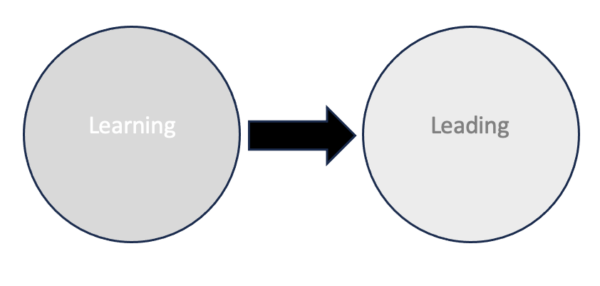Key points:
There was a time when we believed that once you knew how to do something then that was it. Mission accomplished. The skill set was learned and the only thing to do was to put it into practice. It could be improved or mastered through repetition and habit, but the general consensus was that skills were finite.
This was – perhaps still is – true for our students as they check through the content boxes of historical facts, algebraic formulas, and the periodic table. And it was also true of our school leaders. Once they learned the skill set and content knowledge needed to be a principal – let’s call it School Leader 101 – then that was it. Completed and let’s move on. The learning came first and then the leadership began.

We could title this understanding Learning then Leading. They were separate entities and sequential activities.
More recently, learning and leading are both seen as important in the role of school leadership. They aren’t always sequential and sometimes – especially if a leader lacks some new content knowledge or a particular skill set –they relearn or upskill themselves as needed. This was most common when new technology came out or new methods for instruction, assessment, or accountability. Often imposed changes from the outside required new skill sets for leaders.
We could call this Leading and Learning.

What we are starting to see and understand – especially with the fast pace of change – is that school leaders need to be doing both simultaneously. Leading effectively now requires leaders to be learning at the same time. There are new ways of doing things, new skill sets and knowledge that leaders need to know, understand and adapt to. It is no longer enough to rely on past knowledge or skill sets from a couple of years ago. The context in which we lead is constantly changing, which requires leaders to grow and evolve.
This can be defined as Leading as Learning.

But do we really need to see these two things as separate entities or activities? Shouldn’t leading be learning? Learning to improve. Learning to adapt and adjust. Learning to make decisions, bring teams together, and challenging the ways things have been done before. All educators want students to be lifelong learners, so shouldn’t educators including leaders expect the same for themselves. Being good at something means continuous learning and adjustment because our situation, our community, and our world is constantly changing. And these changes are happening at an ever-increasing rate.
Maybe we should break it down to state that Leading is Learning. It is a process of learning everyday where skills aren’t mastered but rather developed, enhanced and refined over time.

For us to be the best leaders, educators, and people we can be, we should embrace that we need to be constantly and consistently learning. Our contexts are changing rapidly. The five-year strategy and even the annual school improvement plan are liable to change multiple times to the point where they are more intentions than confirmed destinations. And so, they should be.
It is not only that our worlds are changing so quickly – who knew of ChatGPT 12 months ago – it is also the realization that learning is part and parcel with who we are and what we do. Leaders must now be full-time learners. Learning by self-reflection. Learning by questioning. Learning by being vulnerable. Learning by becoming uncomfortable. Learning by challenging the status quo.
Rather than feel overwhelmed by adding yet another thing to our to-do list, let’s view it as an opportunity. An opportunity to model and share what we expect of everyone in our schools. As leaders in the learning business, we get to be the Lead Learner and that is a pretty exciting role.
- SEO Powered Content & PR Distribution. Get Amplified Today.
- PlatoData.Network Vertical Generative Ai. Empower Yourself. Access Here.
- PlatoAiStream. Web3 Intelligence. Knowledge Amplified. Access Here.
- PlatoESG. Carbon, CleanTech, Energy, Environment, Solar, Waste Management. Access Here.
- PlatoHealth. Biotech and Clinical Trials Intelligence. Access Here.
- Source: https://www.eschoolnews.com/educational-leadership/2024/01/22/leading-is-learning-school-leaders/
- :is
- :not
- :where
- 01
- 12
- 12 months
- 13
- 425
- 600
- a
- accomplished
- accountability
- activities
- adapt
- adding
- adjust
- Adjustment
- ago
- All
- also
- always
- an
- and
- annual
- Another
- ARE
- AS
- assessment
- At
- author
- BE
- because
- becoming
- been
- before
- began
- being
- believed
- BEST
- both
- boxes
- Break
- bring
- business
- but
- by
- call
- came
- CAN
- challenging
- change
- Changes
- changing
- ChatGPT
- check
- Common
- community
- Completed
- CONFIRMED
- Consensus
- consistently
- constantly
- content
- context
- contexts
- continuous
- contributors
- could
- Couple
- decisions
- defined
- destinations
- developed
- do
- doing
- done
- down
- educators
- effectively
- embrace
- enhanced
- enough
- entities
- especially
- Even
- ever-increasing
- everyday
- everyone
- evolve
- exciting
- expect
- facts
- FAST
- feel
- First
- For
- from
- General
- get
- good
- Grow
- habit
- Happening
- Have
- historical
- How
- How To
- http
- HTTPS
- if
- important
- imposed
- improve
- improved
- improvement
- in
- Including
- intentions
- into
- IT
- Know
- knowledge
- lead
- leader
- leaders
- Leadership
- leading
- learned
- learner
- learners
- learning
- lifelong
- List
- longer
- make
- max-width
- means
- Media
- methods
- Mission
- model
- months
- more
- most
- move
- multiple
- must
- Need
- needed
- New
- no
- now
- of
- often
- on
- once
- only
- Opportunity
- or
- our
- out
- outside
- over
- overwhelmed
- Pace
- part
- particular
- past
- People
- perhaps
- periodic
- plan
- plato
- Plato Data Intelligence
- PlatoData
- Point
- points
- Posts
- practice
- pretty
- Principal
- process
- put
- quickly
- rapidly
- Rate
- rather
- realization
- really
- recently
- refined
- rely
- required
- requires
- Role
- same
- School
- Schools
- see
- seen
- separate
- set
- Sets
- Share
- should
- simultaneously
- situation
- skill
- skills
- So
- some
- something
- sometimes
- Starting
- State
- Status
- Still
- Strategy
- Students
- table
- teams
- Technology
- than
- that
- The
- themselves
- then
- There.
- These
- they
- thing
- things
- this
- Through
- time
- times
- Title
- to
- together
- true
- two
- understand
- understanding
- us
- View
- Vulnerable
- want
- was
- ways
- we
- were
- What
- when
- which
- WHO
- with
- world
- world’s
- years
- yet
- you
- zephyrnet












